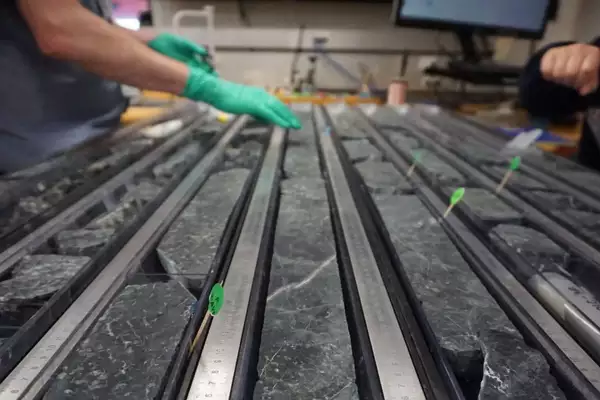Scientists recently penetrated 4,160 feet below the Atlantic seabed, to extract the deepest rock sample from Earth’s mantle, using the ocean drilling vessel JOIDES Resolution.
Key Findings of the research:
- Scientists successfully drilled below the Atlantic seabed, reaching the deepest point ever into Earth’s mantle rock, surpassing previous depth records.
- The recovered core sample is 2,907 feet (886 meters) long, with more than 70% of the drilled rock successfully extracted.
- Analysis of the core sample has revealed how olivine, a key mantle mineral, interacts with seawater at different temperatures.
- These interactions produce hydrogen and methane, compounds that are thought to support microbial life, potentially offering insights into the origins of life on Earth.
- The core was obtained from the Atlantis Massif, near the Lost City Hydrothermal Field, known for its high-temperature hydrothermal vents.
- The Atlantis Massif is an underwater mountain located in the Atlantic Ocean, near the Mid-Atlantic Ridge.
- It is a large geological structure with unusual formation, composed of mantle rocks called peridotites, rather than the typical volcanic rocks found in mid-ocean ridges.
- This setting is thought to reflect conditions similar to those that may have supported early life forms.
- Preliminary studies indicate a broader history of melting within the mantle than previously known.
- The mineral orthopyroxene shows a varied abundance, suggesting complex melt flow patterns in the upper mantle that contribute to volcanic activity.
- This offered a potential for further discoveries about Earth’s deep interior and its impact on geological and biological processes throughout Earth’s history.
Ref: Source
| UPSC IAS Preparation Resources | |
| Current Affairs Analysis | Topperspedia |
| GS Shots | Simply Explained |
| Daily Flash Cards | Daily Quiz |
Frequently Asked Question:
What was the recent achievement of the scientists in their drilling research?
Scientists successfully drilled below the Atlantic seabed and reached the deepest point ever into Earth’s mantle rock, surpassing previous depth records.
How long is the core sample recovered from the drilling?
The core sample is 2,907 feet (886 meters) long, and more than 70% of the drilled rock was successfully extracted.
What significant findings have emerged from the analysis of the core sample?
The analysis revealed how olivine, a key mantle mineral, interacts with seawater at different temperatures. These interactions produce hydrogen and methane, compounds that may support microbial life and provide insights into the origins of life on Earth.



